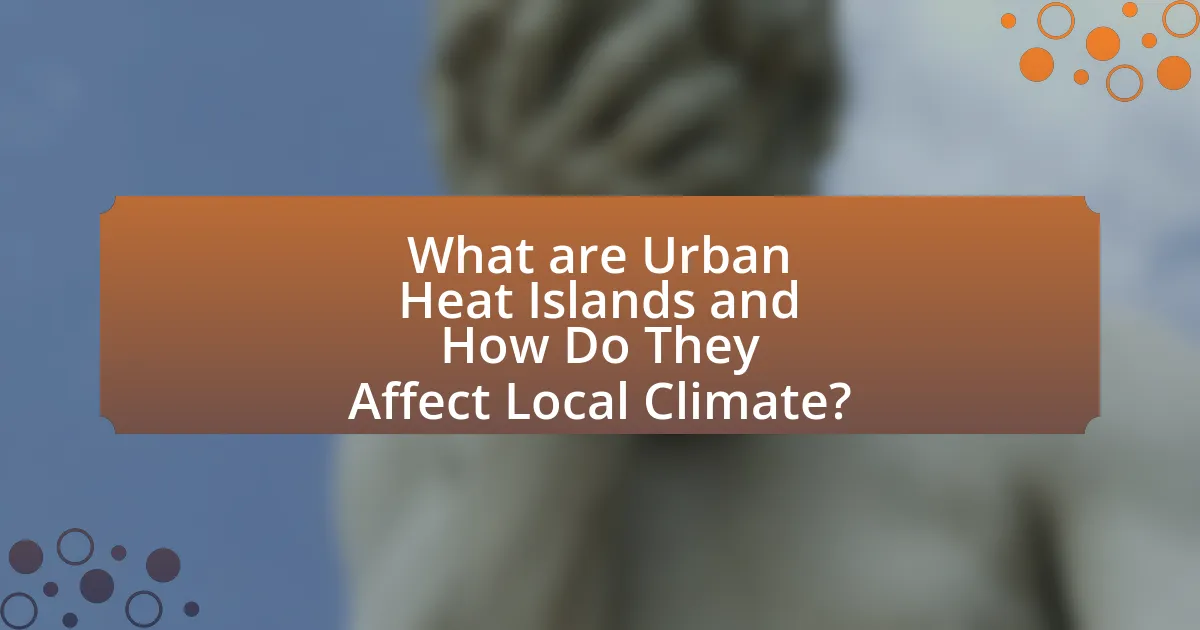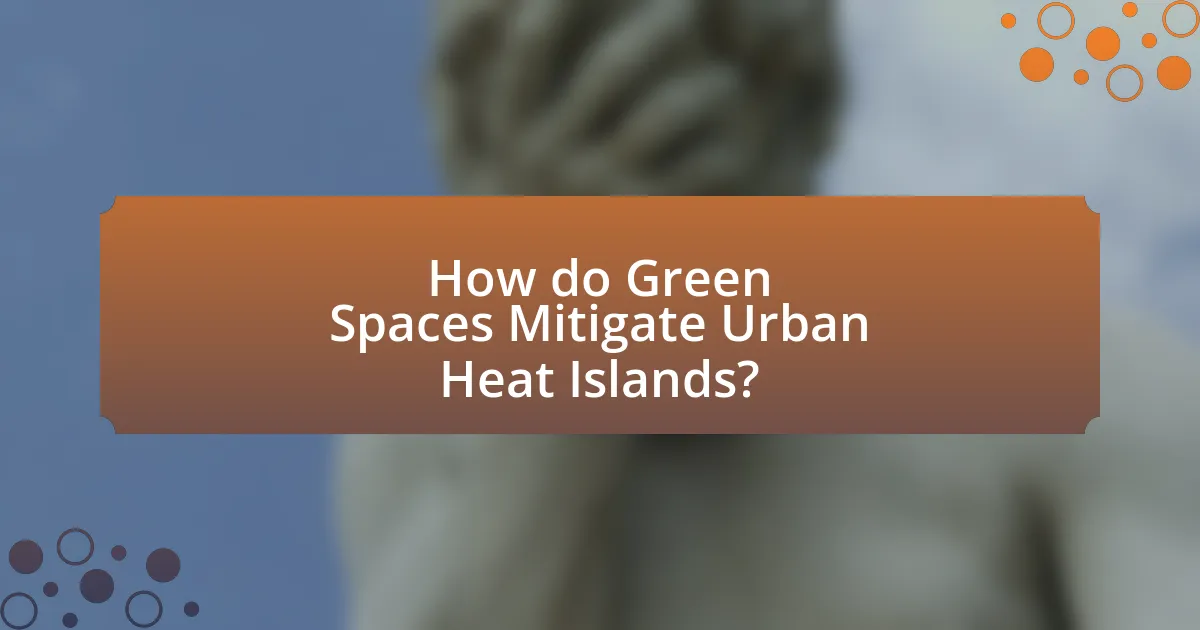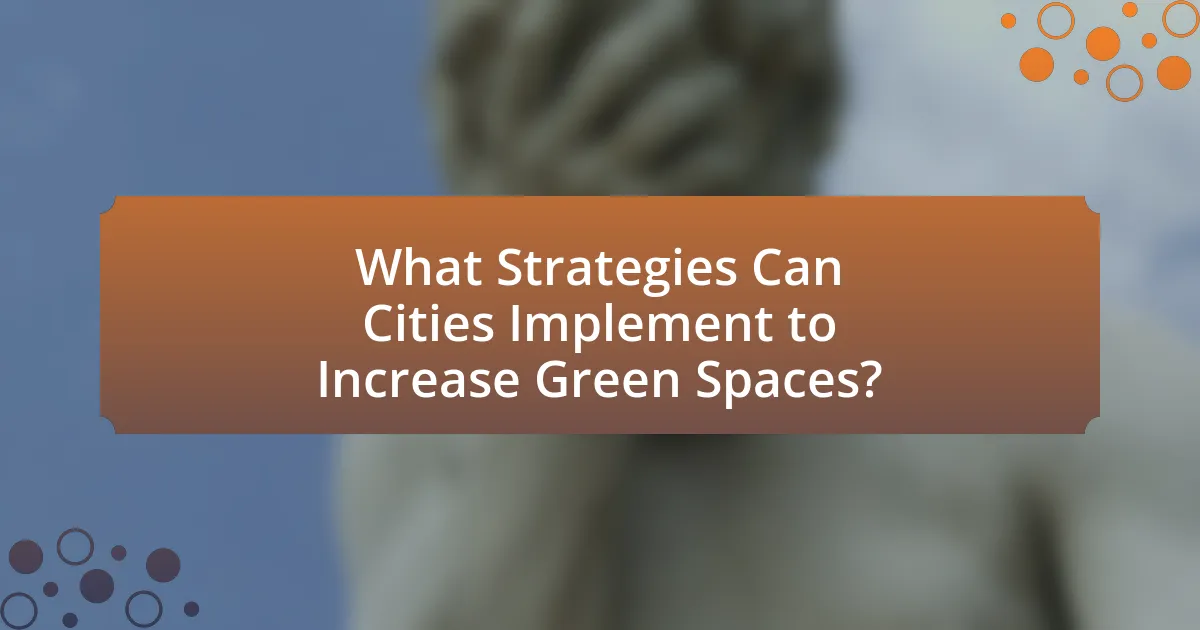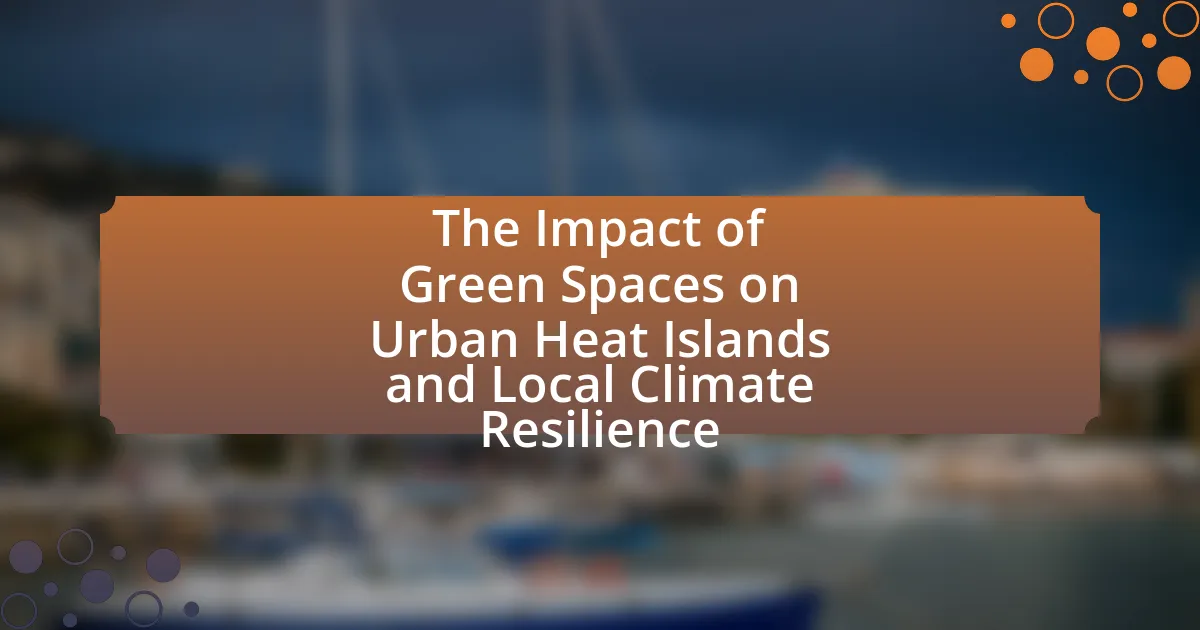Urban Heat Islands (UHIs) are urban areas that experience significantly higher temperatures than their rural surroundings due to human activities and land surface modifications. This article examines the causes and effects of UHIs, including increased energy consumption, elevated air pollution levels, and heat-related health issues. It highlights the role of urban materials and density in temperature variations and emphasizes the importance of addressing UHIs through the implementation of green spaces. The article further explores how parks, green roofs, and urban forestry can mitigate the UHI effect, enhance local climate resilience, and provide additional benefits such as improved air quality and increased biodiversity. Strategies for increasing green spaces and the challenges faced in their implementation are also discussed, along with practical steps individuals can take to support these initiatives in their communities.

What are Urban Heat Islands and How Do They Affect Local Climate?
Urban Heat Islands (UHIs) are urban areas that experience significantly higher temperatures than their rural surroundings due to human activities and modifications to land surfaces. This temperature difference occurs primarily because of the prevalence of concrete, asphalt, and buildings that absorb and retain heat, along with reduced vegetation and soil moisture.
UHIs affect local climate by increasing energy consumption for cooling, elevating air pollution levels, and exacerbating heat-related health issues. For instance, studies have shown that cities can be up to 5-7 degrees Fahrenheit warmer than nearby rural areas, leading to increased demand for electricity and higher rates of heat-related illnesses during summer months.
What causes Urban Heat Islands to form?
Urban Heat Islands form primarily due to the concentration of human activities and infrastructure in urban areas, which absorb and retain heat. This phenomenon is exacerbated by factors such as reduced vegetation, which limits cooling through evapotranspiration, and the prevalence of materials like asphalt and concrete that have high thermal mass. Studies indicate that urban areas can be 2 to 5 degrees Fahrenheit warmer than their rural surroundings, primarily due to these heat-retaining surfaces and the heat generated from buildings, vehicles, and industrial processes.
How do urban materials contribute to heat retention?
Urban materials contribute to heat retention primarily through their physical properties, such as high thermal mass and low albedo. Materials like concrete, asphalt, and brick absorb and store heat during the day, releasing it slowly at night, which leads to elevated temperatures in urban areas. For instance, studies show that urban surfaces can reach temperatures 10 to 15 degrees Fahrenheit higher than surrounding rural areas due to these materials. This phenomenon is exacerbated by the limited vegetation in urban settings, which would otherwise provide cooling through shade and evapotranspiration.
What role does urban density play in temperature variations?
Urban density significantly influences temperature variations, primarily through the urban heat island effect. Higher urban density leads to increased heat retention due to the concentration of buildings, roads, and other infrastructure that absorb and re-radiate heat. Research indicates that urban areas can be 2 to 5 degrees Celsius warmer than surrounding rural areas, with denser cities experiencing even greater temperature disparities. For instance, a study by the U.S. Environmental Protection Agency found that urban heat islands can increase energy consumption for cooling, elevate emissions of air pollutants, and exacerbate heat-related health issues. Thus, urban density directly correlates with elevated temperatures in metropolitan regions.
Why is it important to address Urban Heat Islands?
Addressing Urban Heat Islands is crucial because they significantly increase local temperatures, leading to adverse health effects and higher energy consumption. Research indicates that urban areas can be up to 5-7 degrees Fahrenheit warmer than surrounding rural areas due to factors like reduced vegetation and increased impervious surfaces. This temperature rise exacerbates heat-related illnesses, particularly among vulnerable populations, and increases the demand for air conditioning, which in turn raises energy costs and greenhouse gas emissions. Therefore, mitigating Urban Heat Islands through strategies such as increasing green spaces can enhance public health, reduce energy consumption, and contribute to climate resilience.
What health impacts are associated with increased urban temperatures?
Increased urban temperatures are associated with a range of adverse health impacts, including heat-related illnesses, respiratory issues, and exacerbation of chronic conditions. Elevated temperatures can lead to heat exhaustion and heat stroke, particularly among vulnerable populations such as the elderly and those with pre-existing health conditions. Additionally, higher temperatures contribute to poor air quality, which can aggravate respiratory diseases like asthma and chronic obstructive pulmonary disease (COPD). Studies indicate that urban heat islands can increase mortality rates during heat waves, with a significant rise in emergency room visits for heat-related conditions during extreme temperature events. For instance, research published in the journal Environmental Health Perspectives found that urban areas experience higher mortality rates during heat waves compared to rural areas, highlighting the direct correlation between urban heat and health risks.
How do Urban Heat Islands affect energy consumption?
Urban Heat Islands (UHIs) increase energy consumption primarily due to elevated temperatures in urban areas, which lead to higher demand for air conditioning. Research indicates that cities can be up to 5-7 degrees Fahrenheit warmer than surrounding rural areas, resulting in a significant rise in electricity usage during hot weather. For instance, a study by the U.S. Environmental Protection Agency found that UHI effects can increase energy consumption for cooling by 10-30% in densely populated areas. This increased demand places additional strain on energy resources and can lead to higher electricity costs for consumers.

How do Green Spaces Mitigate Urban Heat Islands?
Green spaces mitigate urban heat islands by providing shade, increasing evapotranspiration, and enhancing air quality. These areas, such as parks and green roofs, lower surface and air temperatures through the cooling effects of vegetation. For instance, a study published in the journal “Environmental Research Letters” found that urban areas with more greenery can experience temperature reductions of up to 5 degrees Celsius compared to those with minimal vegetation. Additionally, trees and plants absorb sunlight and release moisture, which further cools the surrounding environment. This combination of shade and moisture helps to counteract the heat generated by buildings and asphalt, effectively reducing the urban heat island effect.
What types of green spaces are most effective in cooling urban areas?
Urban parks, green roofs, and street trees are the most effective types of green spaces in cooling urban areas. Urban parks provide large areas of vegetation that can lower temperatures through shade and evapotranspiration, with studies showing temperature reductions of up to 5 degrees Celsius in park areas compared to surrounding urban environments. Green roofs contribute to cooling by insulating buildings and reducing heat absorption, with research indicating they can lower rooftop temperatures by 30-40%. Street trees enhance cooling by providing shade and releasing moisture into the air, which can decrease surrounding air temperatures significantly. These green spaces collectively mitigate the urban heat island effect, improving local climate resilience.
How do parks and gardens influence local temperatures?
Parks and gardens lower local temperatures through processes such as evapotranspiration and shading. Evapotranspiration occurs when plants release moisture into the air, which cools the surrounding environment; studies show that this can reduce temperatures by several degrees. Additionally, the shade provided by trees and vegetation prevents direct sunlight from heating surfaces, further contributing to cooler microclimates. Research indicates that urban areas with more green spaces can experience temperature reductions of up to 5 degrees Celsius compared to areas with minimal vegetation, highlighting the significant role parks and gardens play in mitigating urban heat islands.
What is the role of urban forestry in temperature regulation?
Urban forestry plays a crucial role in temperature regulation by mitigating the urban heat island effect through shade provision and evapotranspiration. Trees and green spaces lower surface and air temperatures, with studies indicating that urban areas with higher tree canopy cover can experience temperature reductions of up to 5 degrees Celsius compared to areas with minimal vegetation. This cooling effect is essential for enhancing local climate resilience, as it reduces energy consumption for cooling and improves overall urban livability.
How do green spaces contribute to overall urban climate resilience?
Green spaces contribute to overall urban climate resilience by mitigating heat, improving air quality, and enhancing biodiversity. These areas reduce the urban heat island effect, which can increase local temperatures by up to 5 degrees Celsius compared to surrounding rural areas. Vegetation in green spaces provides shade and cools the air through evapotranspiration, effectively lowering temperatures in densely populated urban areas. Additionally, green spaces improve air quality by absorbing pollutants and producing oxygen, which is crucial for public health. Studies show that urban areas with more green spaces experience lower levels of particulate matter and other harmful emissions. Furthermore, these spaces support biodiversity, which is essential for ecosystem stability and resilience against climate change impacts. For instance, urban parks can host various species, contributing to ecological balance and enhancing the ability of cities to adapt to environmental changes.
What benefits do green spaces provide beyond temperature reduction?
Green spaces provide numerous benefits beyond temperature reduction, including improved air quality, enhanced mental health, increased biodiversity, and greater community cohesion. Improved air quality is achieved through the absorption of pollutants and the release of oxygen by plants, which can lead to a reduction in respiratory diseases. Studies show that urban greenery can lower particulate matter levels by up to 30%. Enhanced mental health is supported by research indicating that access to green spaces reduces stress and anxiety, with a study published in the Journal of Environmental Psychology finding that individuals who spend time in nature report higher levels of well-being. Increased biodiversity is fostered by green spaces, which serve as habitats for various species, contributing to ecosystem stability. Lastly, green spaces promote community cohesion by providing areas for social interaction and recreational activities, which can strengthen neighborhood ties and improve overall quality of life.
How can green spaces enhance biodiversity in urban settings?
Green spaces enhance biodiversity in urban settings by providing habitats for various species, including plants, insects, birds, and mammals. These areas serve as critical refuges that support ecological interactions and promote species richness. Research indicates that urban green spaces can increase local biodiversity by up to 30%, as they offer food sources, nesting sites, and corridors for wildlife movement. For instance, a study published in the journal “Urban Ecology” found that parks and gardens in cities can significantly boost the populations of pollinators, which are essential for plant reproduction and ecosystem health.

What Strategies Can Cities Implement to Increase Green Spaces?
Cities can implement strategies such as creating urban parks, enhancing green roofs, and establishing community gardens to increase green spaces. Urban parks provide recreational areas and biodiversity, while green roofs contribute to insulation and stormwater management. Community gardens foster local food production and community engagement. Research indicates that increasing green spaces can reduce urban heat island effects by up to 5 degrees Celsius, improving local climate resilience and air quality.
What policies can promote the development of green spaces in urban areas?
Policies that can promote the development of green spaces in urban areas include zoning regulations that prioritize green space allocation, financial incentives for developers to include parks and gardens in their projects, and public funding for urban greening initiatives. Zoning regulations can ensure that a certain percentage of land is designated for parks, which has been shown to increase urban greenery and improve local biodiversity. Financial incentives, such as tax breaks or grants, encourage private developers to integrate green spaces into their designs, which can enhance community well-being and property values. Public funding for urban greening initiatives, such as tree planting programs and community gardens, has been effective in cities like New York and Chicago, where studies indicate that increased green space correlates with reduced urban heat island effects and improved climate resilience.
How can community involvement enhance green space initiatives?
Community involvement enhances green space initiatives by fostering local ownership and ensuring that the spaces meet the specific needs of residents. Engaged communities are more likely to participate in the planning, design, and maintenance of green spaces, leading to increased usage and care for these areas. Research indicates that neighborhoods with active community participation in green space projects report higher satisfaction and better environmental stewardship, as seen in the study “Community Engagement in Urban Green Spaces” by the University of California, which found that community-led initiatives resulted in a 30% increase in green space usage and a significant reduction in urban heat island effects.
What funding sources are available for urban greening projects?
Funding sources for urban greening projects include government grants, private foundations, corporate sponsorships, and crowdfunding platforms. Government grants, such as those from the Environmental Protection Agency or local municipalities, often support initiatives aimed at enhancing urban green spaces. Private foundations, like the Trust for Public Land, provide financial assistance for specific greening efforts. Corporate sponsorships can also be a viable source, as companies seek to enhance their corporate social responsibility profiles. Additionally, crowdfunding platforms enable community members to contribute directly to local greening projects, fostering community engagement and investment. These funding avenues collectively support the development and maintenance of green spaces, which are crucial for mitigating urban heat islands and enhancing local climate resilience.
What best practices should cities follow to maintain and expand green spaces?
Cities should implement a combination of community engagement, strategic planning, and sustainable maintenance practices to maintain and expand green spaces. Engaging local communities in the planning process fosters a sense of ownership and ensures that green spaces meet the needs of residents. Strategic planning involves identifying underutilized areas and prioritizing them for green space development, which can include parks, community gardens, and green roofs. Sustainable maintenance practices, such as using native plants and implementing efficient irrigation systems, enhance the longevity and ecological health of these spaces. Research indicates that cities with well-maintained green spaces can reduce urban heat island effects by up to 5 degrees Fahrenheit, thereby improving local climate resilience.
How can cities measure the effectiveness of their green space initiatives?
Cities can measure the effectiveness of their green space initiatives by utilizing metrics such as biodiversity indices, air quality assessments, and temperature regulation data. For instance, studies have shown that urban green spaces can reduce surface temperatures by up to 5 degrees Celsius, which can be quantified through temperature monitoring before and after the implementation of green spaces. Additionally, cities can conduct surveys to assess community engagement and satisfaction with green spaces, which provides qualitative data on their impact. Furthermore, tracking changes in local wildlife populations and plant diversity can serve as indicators of ecological health resulting from these initiatives. These methods collectively provide a comprehensive evaluation of the effectiveness of green space initiatives in mitigating urban heat islands and enhancing local climate resilience.
What are common challenges faced in the implementation of green spaces?
Common challenges faced in the implementation of green spaces include limited funding, land availability, and community engagement. Limited funding restricts the ability to design, construct, and maintain green spaces effectively, as evidenced by a study from the National Recreation and Park Association, which found that 70% of park agencies reported budget constraints as a significant barrier. Land availability poses a challenge in densely populated urban areas where space is at a premium, leading to competition with other land uses. Additionally, community engagement is crucial; without public support and involvement, projects may face opposition or lack the necessary input to meet local needs, as highlighted in research by the Urban Land Institute, which emphasizes the importance of stakeholder collaboration in successful green space initiatives.
What practical steps can individuals take to support green spaces in their communities?
Individuals can support green spaces in their communities by participating in local tree planting initiatives and community gardening projects. Engaging in these activities not only enhances biodiversity but also contributes to reducing urban heat islands, as studies show that increased vegetation can lower surface temperatures by up to 5 degrees Fahrenheit. Additionally, individuals can advocate for local policies that prioritize the preservation and creation of parks and green areas, which is essential for improving local climate resilience. Research indicates that urban areas with more green spaces experience better air quality and reduced flooding, further emphasizing the importance of community involvement in maintaining these vital resources.
